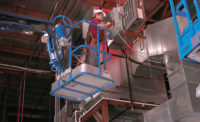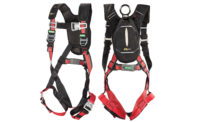Every tool on a jobsite has its own set of operational instructions and safety requirements. Most seem like common sense, and others require a more detailed approach. Ladders are one of those standard, time-tested pieces of equipment that would presumably need no training, yet according to OSHA, falls remain the No. 1 cause of death in the construction industry. The good news? These falls are almost always preventable. But, it all starts with putting ladders in their place – last. To do this, low-level scissor lifts are a contractor’s best ally.
The old standby
Ladders have long been the go-to tools for work-at-height jobs; they are inexpensive, compact and convenient, but that all comes at a cost, and a high one at that — safety.
There will always be a time and place for ladders and when setup and used correctly they can be a great tool for getting high-reach work done. However, setup and usage is also where the problems with ladders arise, and the result of not following proper guidelines can lead to injuries and costs.
OSHA recommends users place extension ladders at a 75-degree angle, set it one-quarter of the working height away from a wall, and ensure the top of a ladder extends 3 feet higher than the elevated surface. Users must also choose ladders that are the appropriate Duty Rating for the task, which ensures it can hold your weight and the weight of your load. And while working on or climbing up and down a ladder, the “3 Point Rule” should always be enforced. This means users must maintain three points of contact at all times to minimize the risk of slipping and falling.
According to a Bureau of Labor Statistics study of 1,400 ladder accidents, 66 percent who were injured had not been trained on how to inspect and set up the ladder.
More manageable
Low-level scissor lifts allow workers to reach up to 25-foot working heights, which accounts for the majority of high-reach work. While many think a lift’s overall size is a setback, low-level units are quite compact and in some cases take up less space than a ladder.
But what about when it comes to navigating through doorways, around tight corners or throughout confined areas? A ladder may be fairly simple to move by collapsing it or folding it up, but the taller it gets, the more cumbersome moving it becomes. Not only do ladders get heavier as they get taller, but those taller heights also make it challenging to get around corners and into tight spaces. Low-level lifts, on the other hand, take lifting and awkward maneuvering out of the equation. A lift also eliminates the risk of a strain associated with lugging around a heavy ladder.
Low-level scissor lifts can never compete with ladders’ light weight, but some of the lightest scissor lift models can be used on tile, laminate and raised floors without the risk of damage.
High risk
High-reach work comes with challenges, and when using a ladder to perform that work, those challenges become compounded and can test the human body. For example, HVAC and plumbing technicians installing pipes and ductwork overhead need ample materials and tools as the job progresses. When they’ve completed one section, they must step down, move the ladder, grab more materials and climb back up. This is not only inefficient, but the repetitive climbing can cause injuries to knees and hips, and standing on the rungs for long periods can lead to painful plantar fasciitis. This scenario also sets the installer up for a fall. In fact, ladder users should never carry heavy objects or tools up the ladder.
In addition, once workers are on the ladder their lateral reach is limited, restricting how much work they can accomplish in one spot. As a result, many are tempted to — and often do — overreach and risk the ladder toppling over. These reasons are why improper ladder usage continues to make OSHA’s Top 10 most cited violations, year after year. In fact, according to the last study provided by the Center for Disease control, 81 percent of all fall injuries among construction workers in 2011 involved a ladder.
Some self-propelled low-level scissor lifts can hold as much as 750 pounds and offer as much as 15 square feet of platform space, including their extensions. That’s plenty of capacity for ample materials and supplies. Also, loading the lift with those supplies is substantially easier and less taxing on the body due to lower platform heights. Operators simply load the lift, step up the 20 or so inches to get on the lift, then drive and elevate. And because workers can load the lift with more materials, they make fewer trips up and down, which enhances productivity.
High price to pay
Most would agree a low-level lift is substantially safer and more efficient than a ladder, but there is still one problem — accessibility to a low-level scissor lift.
It’s not just injuries employers need to worry about, though. Those falls aren’t cheap. Just one worker’s compensation claim can cost tens of thousands of dollars, which is just a fraction of the U.S. Consumer Product Safety Commission’s estimated $24 billion in annual costs associated with ladder injuries.
Under the Occupational Safety and Health Act, employers are responsible for providing employees with a safe workplace. Making safer equipment, such as low-level scissor lifts, available to employees is just one part of the equation, however. Employers must also train employees on when and where to use that equipment.
Aside from minimizing injuries and worker’s compensation costs, there is one more benefit to offering low-level lifts not many talk about: employee retention. The workforce is a different landscape than it was 30 years ago and keeping employees is harder than ever. The younger workforce simply doesn’t want to put their bodies through the day-to-day physical demands of construction work, and those who have been in the industry for years take a bit longer to recover from those tasks.
The benefits of that are twofold — employees get a safe worksite and are generally happier while employers get more productive employees.
Ladders take last
While the learning curve of ladder use is quite shallow, safe usage is not always guaranteed.
Safety isn’t a race, but if it were, ladders wouldn’t stand a chance against low-level scissor lifts’ safe and spacious platforms, easy maneuverability or ergonomics. Ladders will likely always be an option when it comes to work-at-height jobs, but there is a time and place for them, and typically it’s last.







